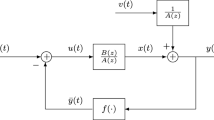Abstract
In this paper, an approach is proposed for solving a nonlinear-quadratic optimal regulator problem with linear static state feedback and infinite planning horizon. For such a problem, approximate problems are introduced and considered, which are obtained by combining a finite-horizon problem with an infinite-horizon linear problem in a certain way. A gradient-flow based algorithm is derived for these approximate problems. It is shown that an optimal solution to the original problem can be found as the limit of a sequence of solutions to the approximate problems. Several important properties are obtained. For illustration, two numerical examples are presented.
Similar content being viewed by others
References
Gonzalez, S., andMiele, A.,Sequential Gradient-Restoration Algorithm for Optimal Control Problems with General Boundary Conditions, Journal of Optimization Theory and Applications, Vol. 26, pp. 395–425, 1978.
Hasdorff, L.,Gradient Optimization and Nonlinear Control, John Wiley and Sons, New York, New York, 1976.
Miele, A., Damoulakis, N., Cloutier, J. R., andTietze, J. L.,Sequential Gradient-Restoration Algorithm for Optimal Control Problems with Nondifferential Constraints, Journal of Optimization Theory and Applications, Vol. 13, pp. 218–255, 1974.
Miele, A., andWang, T.,Primal-Dual Properties of Sequential Gradient-Restoration Algorithms for Optimal Control Problems, Part 1: Basic Problem, Integral Methods in Science and Engineering, Edited by F. R. Payneet al., Hemisphere Publishing Corporation, Washington, DC, pp. 577–607, 1986.
Miele, A., andWang, T.,Primal-Dual Properties of Sequential Gradient-Restoration Algorithms for Optimal Control Problems, Part 2: General Problem, Journal of Mathematical Analysis and Applications, Vol. 119, pp. 21–545, 1986.
Polak, E., andMayne, D. Q.,A Feasible Direction Algorithm for Optimal Control Problems with Control and Terminal Constraints IEEE Transactions on Automatic Control, Vol. 22, pp. 741–751, 1975.
Sirisena, H. R., andChou, F. S.,Convergence of Control Parametrization Ritz Method for Nonlinear Optimal Control Problems, Journal of Optimization Theory and Applications, Vol. 29, pp. 369–382, 1979.
Sakawa, Y.,On Local Convergence of an Algorithm for Optimal Control, Numerical Functional Analysis and Optimization, Vol. 3, pp. 301–319, 1981.
Teo, K. L., Goh, C. J., andWong, K. H.,A Unified Computational Approach to Optimal Control Problems, Longman Scientific and Technical, Essex, England, 1991.
Teo, K. L., andJennings, L. S.,Nonlinear Optimal Control Problems with Continuous State Inequality Constraints, Journal of Optimization Theory and Applications, Vol. 63, pp. 1–22, 1989.
Teo, K. L., andWong, K. H.,Nonlinear Constrained Optimal Control Problems, Journal of Australian Mathematical Society, Series B, Vol. 3, pp. 122–144, 1992.
Jennings, L. S., Fisher, M. E., Teo, K. L., andGoh, C. J.,MISER3: Solving Optimal Control Problems, An Update, Advances in Engineering Software, Vol. 13, pp. 190–196, 1991.
Ahmed, N. U.,Elements of Finite-Dimensional Systems and Control Theory, Longman Scientific and Technical, Essex, England, 1988.
Bryson, A. Y., Jr., andHo, Y. C.,Applied Optimal Control, Hemisphere, Washington, DC, 1975.
Cesari, L.,Optimization: Theory and Applications, Springer Verlag, New York, New York, 1983.
Biswas, S. K., andAhmed, N. U.,Optimal Feedback Control of Power Systems Governed by Nonlinear Dynamics, Optimal Control Applications and Methods, Vol. 7, pp. 289–303, 1986.
Teo, K. L., Fisher, M. E., andMoore, J. B.,A Suboptimal Feedback Stabilizing Controller for a Class of Nonlinear Regulator Problems, Applied Mathematics and Computation, Vol. 59, pp. 1–17, 1993.
Yan, W. Y., Teo, K. L., andMoore, J. B.,A Gradient Flow Approach to Computing LQ Optimal Output Feedback Gains, Optimal Control Applications and Methods, Vol. 15, pp. 67–75, 1994.
Vincent, T. L., Goh, B. S., andTeo, K. L.,Trajectory-Following Algorithms for Min-Max Optimization Problems, Journal of Optimization Theory and Applications, Vol. 75, pp. 501–519, 1992.
Author information
Authors and Affiliations
Additional information
Communicated by T. L. Vincent
This project was partially supported by a research grant from the Australian Research Council.
Rights and permissions
About this article
Cite this article
Teo, K.L., Wong, K.H. & Yan, W.Y. Gradient-flow approach for computing a nonlinear-quadratic optimal-output feedback gain matrix. J Optim Theory Appl 85, 75–96 (1995). https://doi.org/10.1007/BF02192300
Issue Date:
DOI: https://doi.org/10.1007/BF02192300



